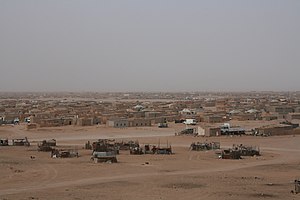
Back مخيمات اللاجئين الصحراويين Arabic Camps de refugiats de la província de Tindouf Catalan Saharaj Rifuĝejoj Esperanto Campos de refugiados de la provincia de Tinduf Spanish Camps de réfugiés sahraouis French מחנות פליטים סהראווים HE Campi profughi Sahrawi Italian 사하라 난민 캠프 Korean De saharawiske flyktningleirene i Tindouf NB Campos de refugiados saarauís Portuguese

| Part of a series on the |
| Western Sahara conflict |
|---|
 |
| Background |
| Regions |
| Politics |
| Clashes |
| Issues |
| Peace process |
The Sahrawi refugee camps (Arabic: مخيمات اللاجئين الصحراويين; Spanish: Campamentos de refugiados saharauis), also known as the Tindouf camps, are a collection of refugee camps set up in the Tindouf Province, Algeria in 1975–76 for Sahrawi refugees fleeing from Moroccan forces, who advanced through Western Sahara during the Western Sahara War. With most of the original refugees still living in the camps, the situation is among the most protracted in the world.[1][2]
The limited opportunities for self-reliance in the harsh desert environment have forced the refugees to rely on international humanitarian assistance for their survival.[3] However, the Tindouf camps differ from the majority of refugee camps in the level of self-organization. Most affairs and camp life organization are run by the refugees themselves, with little outside interference.[4]
The camps are divided into five wilayat (districts) named after towns in Western Sahara; El Aaiun, Awserd, Smara, Dakhla and more recently Cape Bojador (or the daira of Bojador).[5][6] In addition, there is a smaller satellite camp known as "February 27", surrounding a boarding school for women, and an administrative camp called Rabouni.[7] The encampments are spread out over a quite large area. While Laayoune, Smara, Awserd, February 27 and Rabouni all lie within an hour's drive of the Algerian city of Tindouf, the Dakhla camp lies 170 kilometres (110 mi) to the southeast. The camps are also the headquarters of the 6th military region of the Saharawi Arab Democratic Republic.
- ^ Cite error: The named reference
unhcr_2010was invoked but never defined (see the help page). - ^ Cite error: The named reference
hrw_2008was invoked but never defined (see the help page). - ^ Cite error: The named reference
wfp_2010was invoked but never defined (see the help page). - ^ Cite error: The named reference
fmo_2004_cwas invoked but never defined (see the help page). - ^ Cite error: The named reference
arso_1995was invoked but never defined (see the help page). - ^ Fiddian-Qasmiyeh, Elena (May 2011). "Protracted Sahrawi displacement" (PDF). Refugee Studies Centre. Archived (PDF) from the original on 2023-09-17. Retrieved 2023-11-11.
- ^ Cite error: The named reference
fmo_2005_bwas invoked but never defined (see the help page).